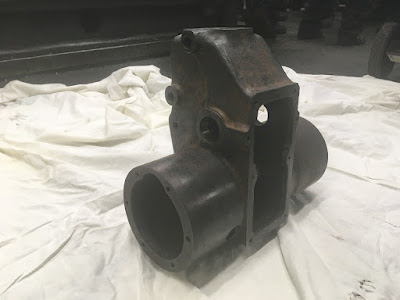If you go
back to 2/11/16 you may recall why the 4415 project team does not
provide horse racing tips; having considered putting money into three
different Diesel engines we decided to back the horse with the broken
leg. This ‘horse’, the MDB4 engine had damage to the crank case,
a broken crankshaft, a damaged piston, no injectors (atomisers in the
language of 1928) and no fuel pump. While we have a very
comprehensive set of drawings for the locomotive and some drawings
for the engine, the set of engine drawings is incomplete. The
drawings we have come from the McLaren archives held at Armley Mills
museum, who also kindly donated the MDB4 engine to the project. In
the back of another of their sheds was something to covet:

This
particular wonky donkey of a horse is a Barford Perkins road roller.
Precise vintage unknown, but the interest from the 4415 project
perspective is that the motive power comes from a McLaren MDB2
engine, the two cylinder variant of the MDB4. The great thing about
the roller engine is that it is substantially complete, with fuel
pump, governor & atomisers. Obviously (by definition) there are
not enough of the components the project needs for cannibalisation,
but cloning is the technology of the future.
In line with
the project ethos, recovery of the roller was done by the team in some
style, that style being provided by Foden, courtesy of Dave Walker.
For the
roller, there must be a sense of déjà vu, it does not look any
happier in its new home in Wales:
The
continued support of the Armley Mills museum to the project is
greatly appreciated. The roller is on loan, to enable investigation
and replication of the components missing from the MDB4 engine. The
governor/ fuel pump assembly (in the photo below) is of particular
interest and can be compared with illustration of the MDB4 from "15/- change":


When the two
photos are compared, the fuel pump assemblies can be seen to be
similar, but not identical, and it is not just that one has two fuel
lines running from it and the other four. It might be because some of
the McLaren drawings we have for the fuel pump are labelled ‘for
Old Type Fuel Pump’ which infers that there
is a new type too. We have some detail drawings and can be very
confident that we can recognize an old type governor ball thrust when
we see one; whether we can tell if the MDB2 fuel pump is ‘old type’
or ‘new type’ will require some expertise that merges the roles
of diesel fitter & chicken sexer, and the governor ball thrust is
very much an integral part of the whole fuel pump assembly.
Whether the
drawing below represents the ‘new’ or the ‘old’ type unit we
do not know, but there’s quite a bit of work in making one of
these.
We’ll keep
you posted on progress.
The other main items of interest are the atomisers. We do have a good set of drawings for these, but it's nice to actually see one.
A reminder:
MDB2. It has two cylinders and therefore two atomisers. It would
have been nice if they were both the same; but which is the new,
improved one?
The ones we
are going to have made are the ones on the right; because we do have
a set of drawings for that type.
Not all the
bits that need to be cloned are complex precise bits of machining.
We also need some interesting castings too. This is a rocker cover
from the MDB2. We need four of these. We’re pleased to welcome Bob
Smith to our team, with the hope that he will enjoy the title of
‘project patternmaker’, because this isn’t the only casting we
need.
Finally from
the roller, something that rocks our world. Proof that the pattern
shop at McLarens did not have a proofreader. We don’t need to clone
the radiator, but we do need to clone the spelling mistake:



























































